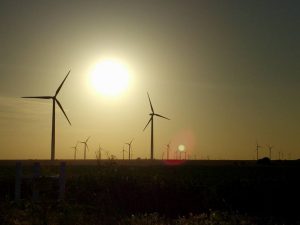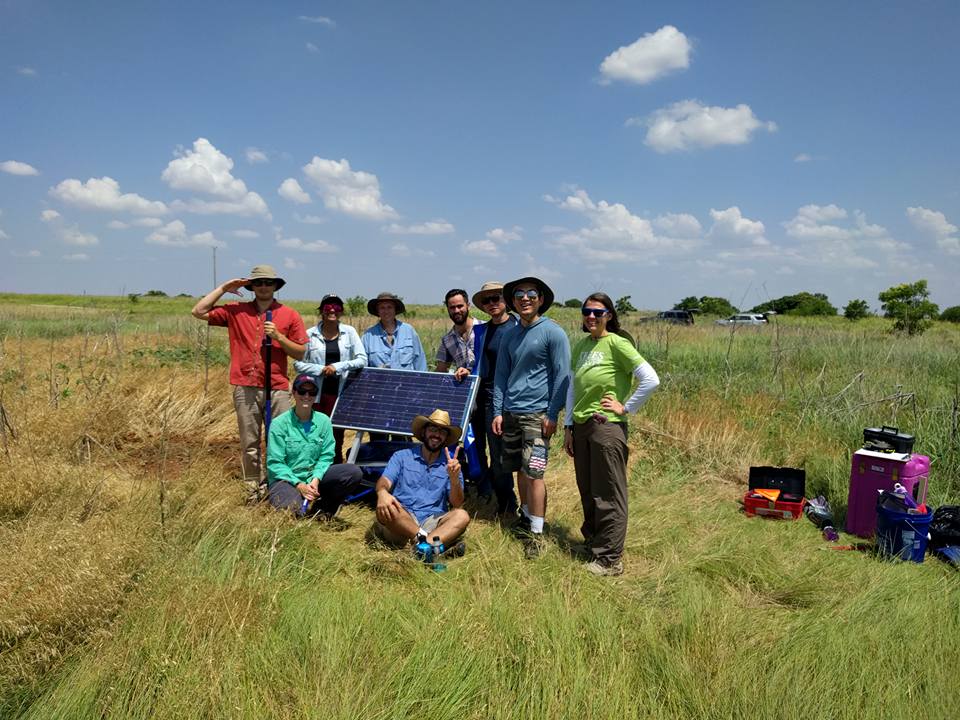
In the last few years, Oklahoma has experienced more earthquakes than California, and this increase in earthquake activity has drawn the attention of local Oklahomans and many seismologists in the United States. Several senior seismologists appealed to Incorporated Research Institutions for Seismology a.k.a IRIS to conduct a community wavefields experiment using cutting-edge seismic instrumentation, namely 3-component nodal-type sensors, to detect earthquake activity and record their propagating waves.
The IRIS consortium and several IRIS community members contributed other types of instrumentation which makes recordings in different frequencies. These included broadband seismometers and infrasound sensors, the latter of which can detect sound waves (e.g. from quarry blasts). In total, 350 nodal sensors, 10 infrasound sensors, and 45 broadband stations were contributed to the IRIS wavefields experiment. UTIG post-doc Chastity Aiken and graduate student Taylor Borgfeldt were part of a team of 60 volunteers – comprising students, post-docs, and professors – who installed these sensors over the course of an extremely hot week in June, about 20 minutes east of Enid, Oklahoma.

Fear of heat exhaustion and heat stroke encouraged work to start as early as 6 A.M. in the morning, when the temperatures were about 25 degrees cooler than the high for the day. This made deploying the sensors much easier, and also provided the team with majestic sunrise views of the numerous wind turbines that lined the horizon.

“By deploying the different sensors, we learned a lot about their capabilities, and the amount of time and space required to get them installed and online for recording. Compared to nodal sensors, broadband seismometers take up a lot more space and require more time to install”, says Chastity.
Nodal sensors are small and compact, and typically 6 inches in diameter. Their spiky feet can be pushed into a 1-foot hole because the battery, data logger, and GPS timer are within the sensor itself, and they are designed to withstand the elements. Due to its compact nature, it takes only two people about 30 minutes to dig a hole and install a nodal sensor. At this rate, hundreds of these nodal sensors can be deployed over several days. However, the sensor itself can record only up to 30 days of seismic data.


Comparatively, the broadband sensor requires a 3-foot hole filled with concrete to make a good recording platform. For protection from rain and insects, plastic barrels and tubes are needed to protect the sensors and their cables connecting the data logger, GPS timer, solar panel, etc. Totally, a 6’ x 6’ area fence is needed to enclose all the equipment and protect it from farm animals at the surface. This can be quite obtrusive and prohibit farmers and ranchers from using their land. “Despite taking up to 6 hours to complete, such an installation is ultimately very rewarding!” says Taylor.

“While working in the fields and ranches, there were interesting sights such as cows and horses walking in the pastures, and bleached bones lying in the ground,” says Chastity. “After each long hard day in the Oklahoma heat, we all just really wanted to shower, have a cool drink, and eat some delicious BBQ!”
The IRIS wavefields experiment provided the team a wonderful opportunity to connect with other seismologists in the community, to learn more about on-going earthquake activity in Oklahoma, and to learn about new seismic technologies that can provide large quantities of data at a low cost of time and money.
For more information about the IRIS community wavefields experiment, you can visit the IRIS website, where the data from the 350 nodal sensors, 45 broadband stations, and 10 infrasound sensors will be made freely available.
